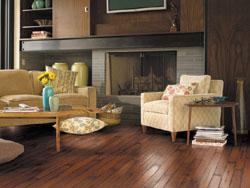Hardwood Update 2008 - October 2008
By Brian Hamilton
Sales of hardwood flooring, which consumers list as their number one flooring of choice, are still having a tough go of it this year after last year’s 12.9% slide, and most manufacturers aren’t very optimistic that the tide is going to turn significantly anytime soon, perhaps not until 2010.
In fact, sales of hardwood are falling more quickly than any other flooring category and are projected to drop another 14% this year, according to Santo Torcivia/Market Insights. The primary reasons are that wood sales are so heavily dependent on the construction of new homes, and the wood industry has very little presence in the commercial market, which has held up fairly well over the last year and a half. Fewer homes are being built than at any time in the last 17 years, at an annual rate of 965,000, according to the Census Bureau. In addition, building permits were at a 26 year low in July, builder confidence continues to fall, and virtually every major builder is suffering substantial losses this year. Credit also remains tight and rule changes for seller financing of new-home-loan down payments are likely to compound the problem for the nation’s largest builders.
The problems are also exacerbated by the poor sales of existing homes. Prices are on the decline—although not evenly across the country—which means many homeowners can’t afford to sell and trade up to a new or larger home. Foreclosures are soaring, which is putting too many homes on the market and further depressing prices. The CEOs of both Lowe’s and Home Depot said they see a depressed market for some time to come, although the bottom of the housing market may be near.
Last year new homes accounted for a third of wood flooring volume, compared to 2006 when it accounted for 54% of all sales, according to Santo Torcivia/Market Insights. U.S. hardwood sales fell from $2.52 billion in 2006 to $2.2 billion last year, according to the U.S. FlooReport, and sales estimates for this year are $1.9 billion.
The National Oak Flooring Manufacturers Association said domestic production was down 5% last year.
The demise late last year of Hoboken, the largest wood distributor in the U.S. with $550 million in sales, had many manufacturers scrambling to find replacements. Some were more successful than others, and for some producers losing Hoboken may have hurt sales at least temporarily. Armstrong, easily the largest hardwood producer, expanded its own distribution company, Patriot Hardwood Floors & Supply, into Pompton Plains, New Jersey, to deal with the Hoboken failure. It also hired some former Hoboken employees.
Several of the manufacturers we talked to said that there appears to be less competition now from low end imports, especially from China. Exchange rates, higher transportation costs, and fewer government subsidies seem to have made the products less competitive.
However, it’s unclear what the impact will be of last year’s amendment to the Lacey Act that was designed to ban the importing of black market lumber, a huge sore point for the hardwood flooring industry. The Lacey Act was originally passed in 1900 to regulate imported fish and wildlife.
Industry insiders have said the new regulations, however well intended, won’t make any difference, and, in fact, may make the situation worse. That’s because U.S. Customs doesn’t have the means to enforce the changes, and some unscrupulous importers are simply applying stamps to their products and shipping them with impunity.
Engineered products now make up about 54% of all hardwood flooring. Many manufacturers are using technology developed in the laminate industry and incorporating click systems on their engineered products to make them easier to install. However, the installation method isn’t being adopted as quickly as it was in laminates, so it’s hard to tell how popular it will become.
In the U.S., the trend continues toward the unique look of handscraped and distressed finishes, as well as exotics, especially in wider planks, while the Canadian manufacturers have largely stayed away from the so-called character looks. Some manufacturers are starting to offer bright colors, which would seem more typical of resilient flooring. It remains to be seen how widespread this might become.
The low and high ends of the market are where most sales are occurring, and the middle price points are hurting. Manufacturers say the low end is keeping their manufacturing operations busy, while the high end is where the money is being made. The unfinished flooring business, which accounts for most of the beautiful floors you see in old homes, is slowly fading into the background. Unfinished flooring is sold based on price and there’s far more profit in finished products.
In addition, Lumber Liquidators, which is becoming the McDonald’s of the hardwood flooring industry, is beginning to have a significant impact. The firm has added 32 stores in the last year and it plans to continue its aggressive expansion for some time to come. Its low cost model, essentially dealing directly with the mills, is helping push prices lower across the industry and across all product lines, from basic oak to handscraped products.
Consolidation in the industry also continues. This summer, Shaw, fresh off its acquisition of Anderson last year, purchased Zickgraf Hardwood, a solid flooring specialist based in Franklin, North Carolina. This should put the company number two in wood sales, still well behind Armstrong, but just ahead of Mohawk. Shaw says it’s still in a growth mode, which could include more acquisitions.
For a breakdown of the players, see the October 2008 issue of Floor Focus Magazine.
Copyright 2008 Floor Focus
Related Topics:Mohawk Industries, Shaw Industries Group, Inc., Armstrong Flooring, Lumber Liquidators
